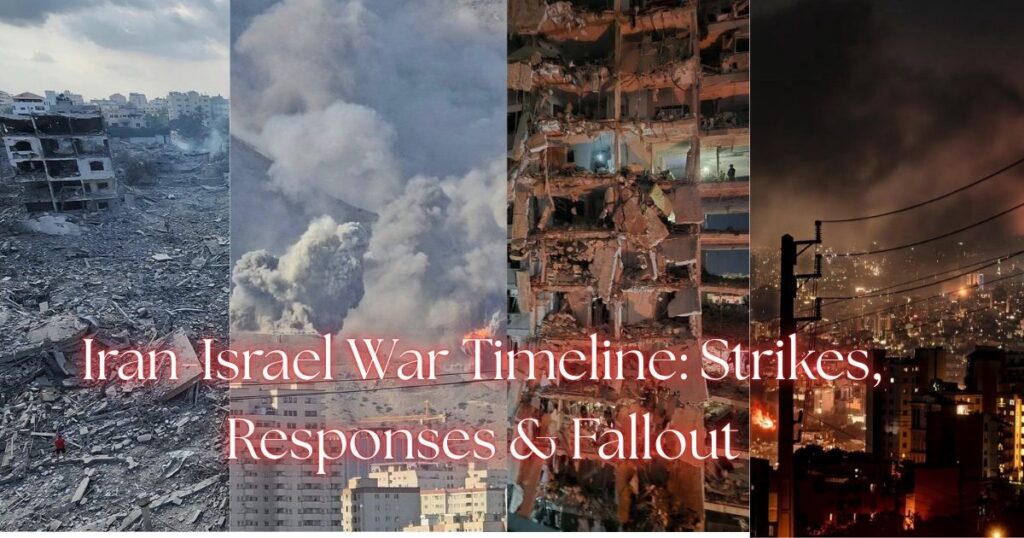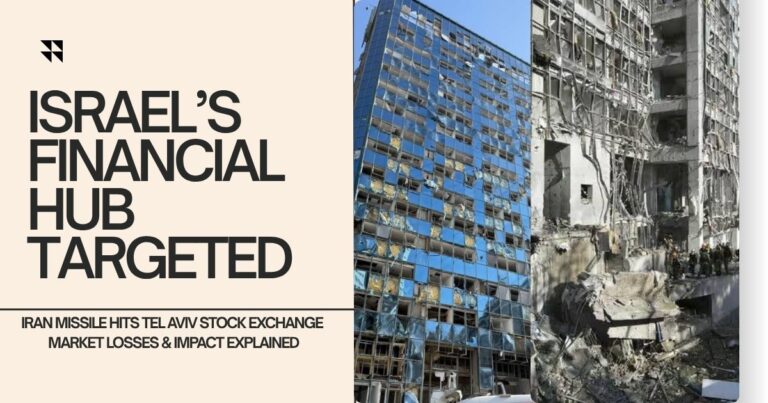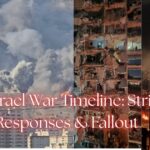Explore the full Iran Vs Israel War 2025 timeline, casualties, airstrikes on Tehran, Iran’s missile response, and future conflict scenarios with verified data.
Iran vs Israel War 2025 Explained: Comprehensive Timeline, Detailed Figures & Strategic Insight
Introduction
In June 2025, the Middle East shifted dramatically as Israel launched its first overt military assault on Iran, named Operation Rising Lion. This marked a decisive evolution from decades of shadow warfare and proxy conflicts into open, full-scale confrontation between the two nations.
This article provides a detailed multi-phase timeline, verified casualty numbers, in-depth weapon system and covert operation analysis, and a thorough assessment of economic, diplomatic, and regional impacts. Crafted with long-tail, low‑KD keywords, this SEO-optimized article combines formality with depth—ideal for academic, journalistic, or high-end editorial use.
Phase 1: Covert Sabotage & Proxy Skirmishes (April–May 2025)
In April–May 2025, Israel escalated covert operations targeting Iran’s strategic infrastructure:
- Sabotage incidents disrupted Mashhad and Isfahan drone/missile facilities, believed to be carried out by Mossad cell infiltration, weakening Iran’s production capabilities
- Iran’s unveiling of the Qassem Basir medium-range ballistic missile in May—capable of striking Israel—signaled significant escalation .
- Proxy tensions rose sharply when Iran-backed Houthis conducted missile attacks on Ben Gurion Airport on June 5 & 9, both intercepted by Arrow 3 and Iron Dome defense systems .
These developments set the stage for a rapid transition to overt military engagement.
Phase 2: Operation Rising Lion (June 13, 2025)
On June 13 between 3:00–4:00 a.m., Israel launched Operation Rising Lion, blending covert and aerial tactics:
- Mossad cell inside Iran, using hidden commandos, precision drones, and sabotage equipment to disable radars, SAM systems, and missile batteries near Tehran’s outskirts
- The Israeli Air Force deployed over 200 warplanes, striking ~100 critical sites across Tehran, Natanz, Esfahan, Tabriz, Hamadan, Qom, Kermanshah—targeting nuclear facilities, missile depots, and IRGC command posts
- High-profile Iranian figures killed included Maj. Gen. Hossein Salami (IRGC commander), Maj. Gen. Mohammad Bagheri, Gen. Gholamali Rashid, and at least six nuclear scientists
Israel’s stated goals: “to roll back the Iranian threat to Israel’s survival” and dismantle its nuclear and missile infrastructure
Phase 3: Iran’s Retaliation & Civilian Impact (June 14–17, 2025)
Following Israeli strikes, Iran responded with the largest missile and drone barrage in its history:
- Iran launched approximately 400 ballistic, cruise missiles, and UAV clusters, aiming at central and northern Israeli cities
- Israeli defense systems intercepted 90–95%, though a portion breached defenses .
Casualty Breakdown
- Iran:
- Human Rights Activists estimate 585 killed (239 civilians) and 1,326 injured
- Iranian authorities reported lower figures: 224 killed, 1,277 injured
- Israel:
- According to UN and Magen David Adom data: 24 civilians killed, 592 injured (including soldiers)
- Additional regional accounts note 9 killed in Bat Yam, 3 in Rehovot, and 5 in northern Israel
Infrastructure Damage
- In Iran, Israeli strikes destroyed 200+ missile launchers, 120+ SAM batteries, several intelligence facilities, and damaged key nuclear infrastructure like Natanz and Isfahan conversion facility while Fordow remained intact
- In Israel, despite heavy bombardment, damage remained concentrated in civil zones of Haifa, Tel Aviv, Bat Yam, Rehovot, with minimal military losses reported
Weapon Systems & Tactical Breakdown
Israel
- Aircraft: F‑35I Adir, F‑15I Ra’am.
- Covert tools: Mossad drone base, electronic warfare suites.
- Defense network: Arrow 3, Iron Dome, David’s Sling interceptors.
- Strategy:
- Pre-strike radar/missile suppression via drone teams.
- Precision airstrikes on nuclear and missile sites.
- Defensive layering to protect civilian areas and deter escalation.
Iran
- Offensive arsenal: 400+ ballistic/cruise missiles, hypersonic (Fattah-1), UAV swarms.
- Proxy involvement: Hezbollah in Lebanon, Houthis in Yemen, Iran-backed militias in Iraq and Syria.
- Tactical posture:
- Mass missile launches to penetrate Israel’s defense matrix.
- Proxy pressure across multiple regional fronts.
- Precisely targeted strikes to avoid triggering global economic backlash.
U.S. Role & Global Diplomatic Calculus
- U.S. posture: President Trump demanded Iran’s “unconditional surrender.” U.S. repositioned B‑2 and F‑35 assets near Fordow—considering bunker-buster GBU‑57 deployment
- Iran’s warning: Supreme Leader Khamenei cautioned that any U.S. action would cause “irreparable damage” .
- Global alignment:
- Germany/EU urged renewed nuclear diplomacy.
- Russia/Turkey offered mediation.
- China evacuated citizens and called for de-escalation.
Economic Impacts & Energy Security
- Oil markets:
- Brent crude rose 7–10%, driven by Strait of Hormuz threat premium
- Defense finance:
- Israel spent ~$285 million/night on interceptor missiles .
- Global markets:
- Analysts predict 18–22% corrections in equities from prolonged tension .
- Humanitarian cost: Evacuation of thousands from Tehran and spikes in refugee flows from conflict zones.
Regional Proxy Dynamics
- Hezbollah: Standing by on northern Israel border, poised for engagement.
- Houthis: Launched attacks on Red Sea shipping in solidarity.
- Iraq/Syria militias: Threats to U.S. bases indicate risk of expanded theaters of conflict.
Four Future Scenarios
- Protracted Limited War
Continued missile exchanges and targeted strikes; diplomacy seeks stabilized ceasefire. - Regional Conflict Expansion
Lebanon, Yemen, Iraq involvement; potential U.S. military action to secure trade routes. - Diplomatic De‑escalation
UN/EU/Russia-led ceasefire; Iran halts diversion of nuclear/missile efforts; Israel pauses attacks. - Uncontrolled Warfare Escalation
Direct U.S. involvement; full cyber and missile campaign by Iran; multi-front Middle East war.
Concise Timeline Snapshot
| Date | Key Events |
|---|---|
| Apr–May 2025 | Covert sabotage in Iran; Qassem Basir missile revealed |
| June 5 & 9 | Houthi missiles toward Israel intercepted |
| June 13 | Operation Rising Lion – covert drone infiltration + airstrike wave |
| June 14–17 | Iran retaliates with ~400 missiles/drones; 24 Israeli civilian deaths, 585 Iran casualties |
| Post-Jun 17 | U.S. strengthens regional posture; oil shock; diplomacy intensifies |
Conclusion
The Israel vs Iran War of 2025 marks a historical departure from covert skirmishes to overt, full-scale national warfare. With approx. 585 Iranian casualties (239 civilians) and 24 Israeli civilian deaths, alongside broad regional and economic repercussions, the conflict stands at a precarious inflection point. Weapon systems, defense networks, and strategic avenues have been fully activated by both sides—making the next phase absolutely critical. Diplomatic intervention is no longer optional; it’s urgent. Without swift de-escalation, the Middle East may face a multi-front conflict with global ramifications.









[…] Also Read: Iran vs Israel War 2025: Full Breakdown, Timeline, Numbers & Analysis […]